When it comes to answering the question ‘do horses need blankets during cold weather’ there is no one-size-fits-all answer.
Each horse is unique and will have different needs based on factors such as their hair coat, living situation, age, body condition, and the lowest temperature at which they can maintain their core temperature without using additional energy.
In this article, we will explore the various factors to consider when deciding whether or not to blanket your horse, as well as the pros and cons of doing so, different viewpoints on the topic, and recommendations based on scientific research and expert opinions.
Should You Blanket Your Horse Video
Table of Contents
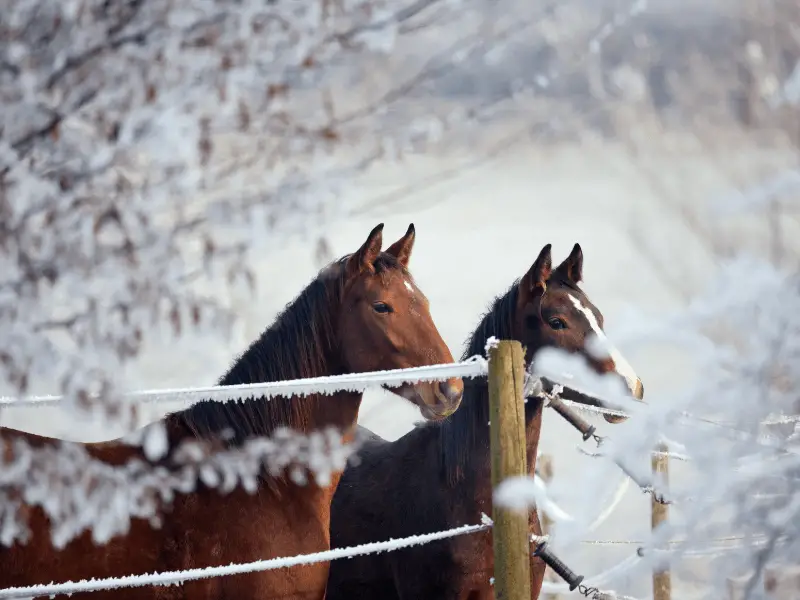
Different Viewpoints on Blanketing Horses
There are various opinions and perspectives on whether or not to blanket horses during the winter months. Let’s explore some of these differing viewpoints to help you make a well-informed decision.
The “Natural” Approach
Some horse owners, trainers, and stable managers believe that horses should be allowed to rely on their natural abilities to stay warm during the winter months.
They argue that horses have evolved to survive in various climates and that their natural winter coats are sufficient for most weather conditions.
This approach often involves providing horses with adequate shelter, free access to hay or other forage, and regular grooming to maintain the insulating properties of their coats.
The “Protective” Approach
Others argue that certain situations, such as extreme weather conditions, clipping, or health issues, may require the use of a blanket to keep horses warm and comfortable during the winter months.
Proponents of this approach emphasize the importance of choosing the appropriate blanket for each horse’s individual needs, ensuring a proper fit, and regularly checking for signs of discomfort or damage.
The “Balanced” Approach
A third viewpoint combines elements of both the “natural” and “protective” approaches.
Advocates of this perspective believe that while horses are generally well-equipped to handle cold temperatures, some situations may necessitate the use of blankets.
They stress the importance of carefully evaluating each horse’s unique needs, considering factors like coat type, shelter availability, age, and body condition, and adjusting their blanketing strategy accordingly.
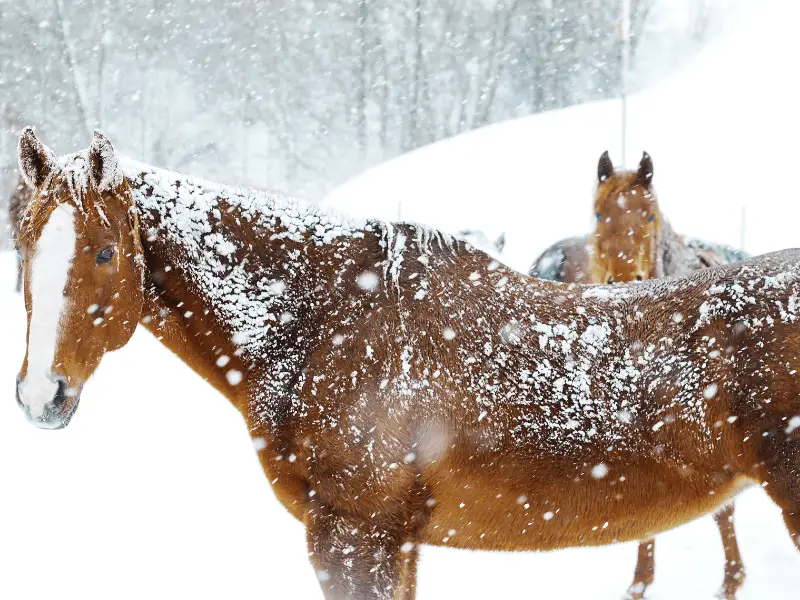
Understanding Your Horse’s Winter Coat
A horse’s winter coat plays a significant role in determining whether or not they need a blanket during the colder months. To make an informed decision, it’s important to understand the characteristics of your horse’s coat and how it functions to keep them warm.
Horses grow a thicker, longer coat in response to decreasing daylight hours and colder temperatures. This winter coat consists of two types of hair: a soft, insulating undercoat and longer, coarser guard hairs.
The combination of these hairs creates a layer of trapped air close to the skin, which serves as insulation and helps to maintain the horse’s core body temperature.
Regular grooming is essential for maintaining the insulating properties of your horse’s winter coat. By removing dirt, sweat, and dead hair, you can help ensure that your horse’s coat remains clean, fluffy, and able to trap air effectively.
Grooming also stimulates blood flow to the skin, promoting healthy hair growth and increasing the coat’s overall insulating capacity.
Common Misconceptions about Horse Blanketing
Hair matting down under a blanket
Some people believe that a horse’s hair will mat down under a blanket, causing them to lose warmth. While it’s true that a blanket can compress the hair, it doesn’t necessarily mean the horse will be colder.
A properly fitted blanket provides insulation and helps maintain the horse’s body temperature, even if their hair is compressed.
Balancing horse’s natural coat with their needs
Blanketing should be done in a way that complements a horse’s natural coat, not inhibits it.
This means choosing the right type and weight of blanket for your horse’s specific needs, and adjusting it as needed based on weather conditions and your horse’s comfort level.
It’s also important to remove the blanket regularly to check your horse’s condition and ensure they’re not overheating.
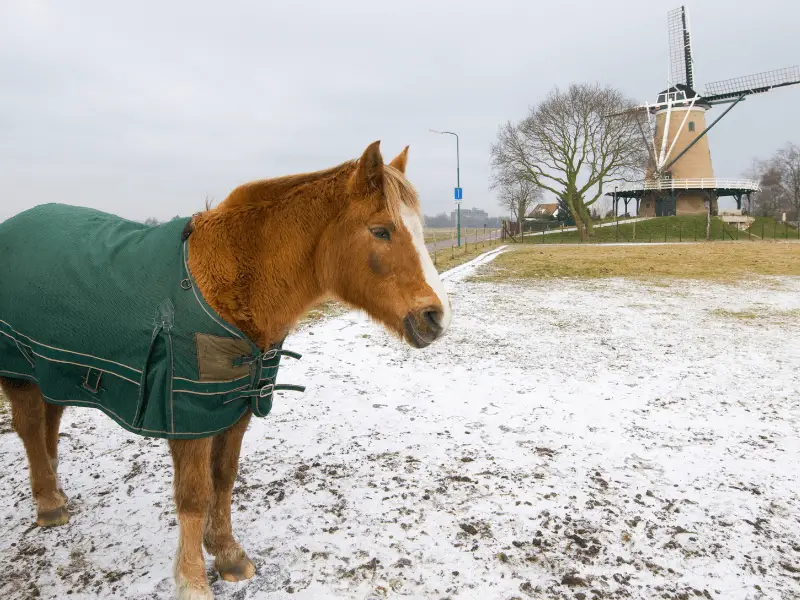
Factors to Consider For Blanketing
Every horse is different so let’s go over the factors that affect whether a horse should wear a blanket or not.
Horses with a full winter coat may not need a blanket, while horses that are clipped or have sleek show coats will definitely need one to stay warm.
Horses with access to shelter may not need a blanket, but horses without shelter will need a waterproof sheet or blanket to stay warm and dry.
Senior horses may need a blanket to help them retain body heat and regulate their temperature.
Easy keepers may not need a blanket, while hard keepers may burn extra calories trying to stay warm, making a blanket a smart choice.
A horse’s lower critical temperature (LCT) is also a factor to consider, as it is the lowest temperature at which they can maintain their core temperature without using additional energy and can vary based on the temperatures the horse is used to, so geography plays a role.
| Factor | Blanket Required | Blanket Not Required |
|---|---|---|
| Hair Coat | Clipped or thin coat | Thick, natural winter coat |
| Living Situation | Inadequate shelter or poor insulation | Adequate shelter or well-insulated barn |
| Age | Young or senior horses | Middle-aged horses |
| Body Condition | Underweight or hard keeper | Ideal body condition or easy keeper |
| Lower Critical Temperature | Temperature below the horse’s LCT | Temperature above the horse’s LCT |
| Geography | Colder regions with more severe winters | Milder climates with less extreme winters |
| Weather Conditions | Exposure to rain, snow, or wind | Calm, dry weather conditions |
Hair Coat
A horse’s hair coat plays a crucial role in keeping them warm during cold weather.
Their winter coat is much thicker than their summer or show coat, and the hairs stand up to trap warm air close to the skin. This is known as “lofting” and is a natural insulating mechanism that helps horses maintain their body heat.
However, when a horse is clipped for showing or other purposes, they lose this natural insulation. In such cases, blanketing becomes necessary to provide the extra warmth they need.
Living Situation
Shelter is an essential factor to consider when deciding whether to blanket your horse or not. Horses living outdoors with access to adequate shelter like a three-sided shed, a windbreak, or a natural wooded area can often cope well without a blanket.
The shelter protects them from wind, rain, and snow, allowing them to maintain their body temperature more effectively.
However, if a horse is housed in a stable or a barn with poor insulation, they may require a blanket to stay warm. Similarly, horses that are turned out without access to proper shelter might need the added protection of a blanket.
Age
A horse’s age can also play a significant role in their ability to stay warm. Young horses and senior horses typically have a harder time regulating their body temperature than their middle-aged counterparts.
Foals and young horses have not yet developed a robust winter coat, while senior horses might struggle due to a weakened immune system, dental issues that affect their ability to eat and maintain body weight, or other age-related health problems.
In these cases, blanketing can provide the extra warmth and protection these horses need to stay comfortable and healthy during cold weather.
Body Condition
A horse’s body condition is another essential factor to consider when deciding whether to blanket them. Horses with an ideal body condition have enough fat reserves to help insulate them from the cold.
However, horses that are underweight or “hard keepers” might struggle to stay warm and may require a blanket for added insulation.
On the other hand, “easy keepers” or overweight horses can usually cope well without a blanket, thanks to their extra fat stores. Just keep in mind that blanketing an overweight horse can cause them to overheat, which could lead to other health problems.
Lower Critical Temperature and Geography
The Lower Critical Temperature (LCT) is the temperature at which a horse starts to feel cold and needs to burn more energy to maintain its body temperature.
LCT varies depending on factors such as hair coat, body condition, and the horse’s overall health. It also differs based on geography, as horses adapt to their local climate.
For instance, a horse living in a mild climate like California may have a higher LCT than a horse in a colder region like Minnesota. When the temperature drops below a horse’s LCT, they may require a blanket to help them stay warm and comfortable.
It’s important to monitor your horse’s comfort level and adjust their blanketing as needed based on the local climate and weather conditions.
Ask yourself the following questions when deciding whether or not to blanket your horse:
- Does my horse have a full winter coat or a clipped coat?
- Does my horse have access to shelter?
- Is my horse a senior or a youngster?
- Is my horse an easy keeper or a hard keeper?
- What is my horse’s LCT and how does it compare to the current temperatures?
Factors that may require a horse to wear a blanket
- Clipped or thin coat
- Inadequate shelter
- Young or senior age
- Underweight or hard keeper
- When the temperature drops below the horse’s LCT
- Exposure to rain, snow, or wind
Factors that may mean a horse does not need a blanket
- Thick, natural winter coat
- Access to adequate shelter
- Ideal body condition
- Horse’s LCT is not reached
Decision to blanket should be based on the horse’s unique needs
The decision to blanket a horse should always be based on their individual needs, taking into account factors like hair coat, living situation, age, body condition, and geography.
It’s essential to monitor your horse’s comfort and adjust their care as needed.
If you’re unsure whether your horse requires a blanket, consult with a veterinarian or an experienced horse care professional. They can help assess your horse’s unique needs and recommend the best course of action.
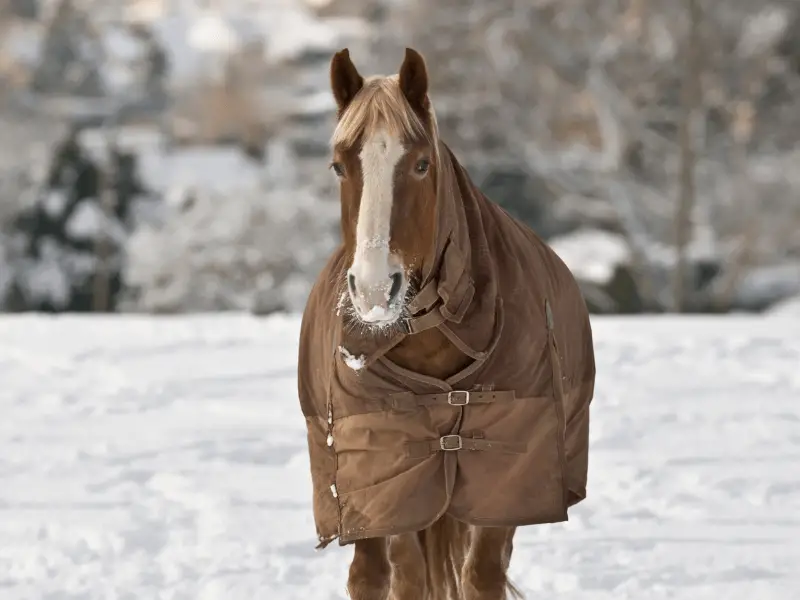
The Pros and Cons of Blanketing Horses
Factors such as clipped coats, lack of shelter, senior age, and thin body condition may require a horse to wear a blanket.
However, horses with a full winter coat, access to shelter, easy keepers, and accustomed to cold temperatures may not need a blanket.
It’s important to remember that the decision to blanket should be based on the horse’s unique needs, and not just because the owner is cold.
Pros of Blanketing Horses:
- Provides warmth and insulation for horses with clipped or thin coats
- Protects horses from harsh weather elements, such as rain, snow, and wind
- Helps senior horses or those with health issues regulate body temperature
- May improve a horse’s overall comfort and well-being during extreme weather conditions
Provides warmth and insulation:
Blanketing is particularly beneficial for horses that have been clipped or have thin coats, as they may struggle to retain heat during colder months.
A well-fitting blanket can provide the insulation needed to keep these horses warm and comfortable.
Protects horses from harsh weather elements:
Blankets can shield horses from cold temperatures, precipitation, and strong winds. This protection can be crucial for horses that live in areas with harsh weather conditions, as it helps to keep them dry, which in turn prevents health issues such as chills and hypothermia.
Helps senior horses:
Older horses and those with certain health conditions may have difficulty maintaining their body temperature. Blanketing can provide additional support for these horses, helping them to stay warm and comfortable, reducing the risk of illness or injury.
Improves well-being during extreme weather conditions:
A well-fitted blanket can help a horse feel more comfortable during extreme weather, reducing stress and promoting relaxation. This can lead to better overall health and well-being for the horse, as well as improved performance for working or competition horses.
Cons of Blanketing Horses:
- May cause overheating if not properly managed
- Can lead to sores and rubs if the blanket doesn’t fit well or is not maintained
- May inhibit natural temperature regulation in some horses
- Requires regular monitoring and maintenance, which can be time-consuming and labor-intensive
May cause overheating:
If a horse is left wearing a blanket that is too heavy for the ambient temperature, it may cause the horse to overheat, which can lead to dehydration, heat stress, or even heatstroke. It is essential to monitor and adjust the weight of the blanket according to the weather conditions.
Can lead to sores and rubs:
An ill-fitting blanket or one that is not properly maintained can cause sores and rubs on a horse’s body. These abrasions can be painful and may lead to infection if not treated promptly.
To prevent this, it is crucial to select a blanket that fits the horse correctly and to regularly check for signs of wear or damage, adjusting or replacing the blanket as needed.
May inhibit natural temperature regulation:
Horses have evolved to regulate their body temperature through their coat, which can grow thicker in colder weather to provide insulation.
By blanketing a horse, you may interfere with this natural process, potentially making it more difficult for the horse to adapt to changing temperatures.
Requires regular monitoring and maintenance:
Blanketing a horse involves more than just putting a blanket on and leaving it there. It requires daily monitoring to ensure the horse is comfortable, adjusting the blanket as needed, and regular maintenance to keep the blanket clean and in good condition.
This extra work may be burdensome for some horse owners or caretakers, particularly if they have multiple horses to look after.
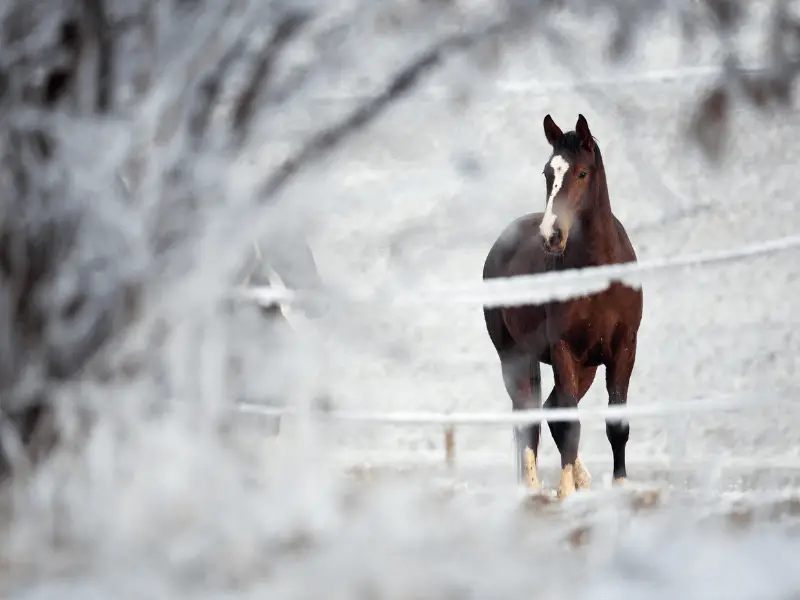
The Final Verdict
Horse blanketing is a personal decision that should be based on each horse’s individual needs. There is no one-size-fits-all answer to the question of whether or not to blanket a horse, as every horse is unique and has different requirements.
We’ve discussed the factors to consider when deciding whether to blanket a horse or not, different viewpoints on the topic, and common misconceptions about horse blanketing.
The key takeaway is that the decision to blanket should be based on the individual needs of your horse, taking into account their hair coat, living situation, age, body condition, and geography.
Use the knowledge you’ve gained from this article to decide whether or not to blanket your horse. If you’re unsure, consult with a veterinarian or an experienced horse care professional who can help assess your horse’s unique needs and recommend the best course of action.
Remember, the ultimate goal is to keep your horse comfortable, healthy, and safe during cold weather. Regularly monitor your horse’s condition, and adjust their care as needed based on their comfort level and the changing weather conditions. By staying informed and attentive, you can ensure that your horse stays warm and happy all winter long.
So, one more time do horses need blankets? It depends! Each horse is different, and their need for a blanket will vary based on their unique circumstances. As a responsible horse owner, it’s up to you to make the best decision for your equine companion. Happy blanketing!
For more information on how horses stay warm in winter and other related topics, check out this informative article: How Do Horses Stay Warm in Winter?
| Key Takeaways |
|---|
| 1. Blanketing a horse depends on individual needs and factors such as coat type, shelter, age, and body condition. |
| 2. The natural approach relies on a horse’s natural coat for warmth, while the protective approach uses blankets in certain situations. The balanced approach combines both. |
| 3. A horse’s winter coat consists of insulating undercoat and longer guard hairs; regular grooming helps maintain its insulating properties. |
| 4. Blanketing can provide warmth and protection in extreme weather, for senior or young horses, and for horses with clipped coats. |
| 5. Factors that may require a horse to wear a blanket include a thin coat, inadequate shelter, young or senior age, being underweight, and exposure to harsh weather |
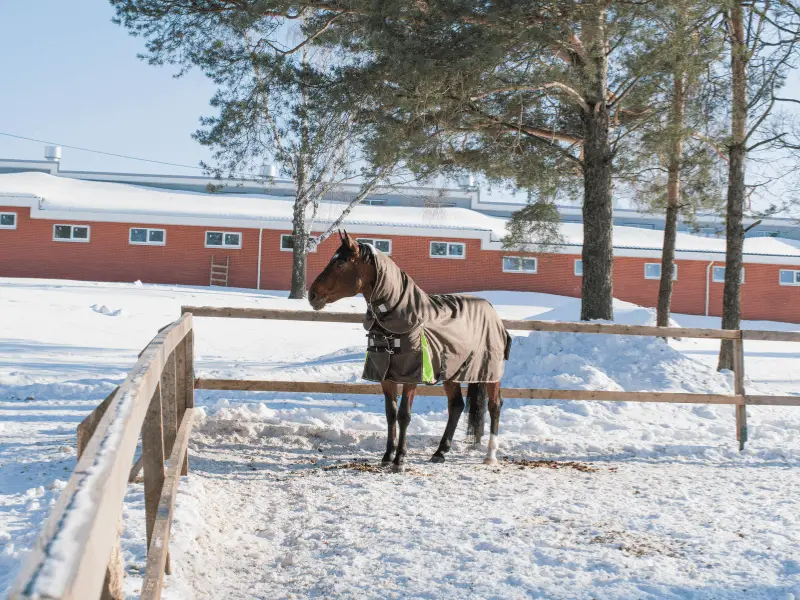
FAQs on Blanketing Horses
To help you make an informed decision on whether or not to blanket your horse, here are some frequently asked questions and their answers:
Q: What temperature does a horse need a blanket?
Q: When should I put a blanket on my horse?
Q: When should I take my horse’s winter blanket off?
Q: Should I blanket a wet horse?
Q: When should I blanket an old horse or a clipped horse?
With a better understanding of the factors that determine whether a horse needs a blanket in the winter, you can make an informed decision about whether to blanket your horse.
Cheers, Kacey
P.S. Did you like this article? Gallop over to:

